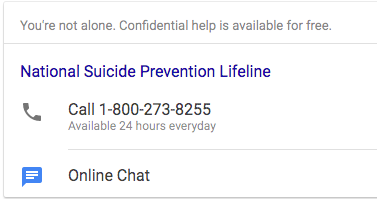
Suicide prevention is all about healing from the underlying core issues of hopelessness and despair. Suicidal ideation, plans, and attempts are all a function of these feelings.
Is it possible to take proactive steps to stop these thoughts and dispair?
Yes, it is possible to take proactive steps to dealing with dark thoughts and depression.
The most important piece of recovery is working with hopelessness and despair in a loving, non-judgmental way.
Suicide Crisis Resources
 That said, if you or your loved one is in a serious crisis, call 911 or the National Suicide Hotline @ 800-273-8255 immediately.
That said, if you or your loved one is in a serious crisis, call 911 or the National Suicide Hotline @ 800-273-8255 immediately.
When people are in deep crisis, the most caring thing to do is to make use of emergency services and access trained professionals.
Know that if you are a danger to yourself, you may get put into a 72-hour hold for your own protection.
Though it might sound scary, it’s not awful if it’s necessary … and it’s certainly preferable to the alternative.
Suicide Prevention: Not Just "Thinking Positive"
The solution to dark and suicidal thoughts is not about just “thinking positive” right away.
Instead, it’s about allowing those desperate parts of you to feel what they feel, and then assigning them new tasks and integrating them into your life in a healthy way.
Say you have a loved one who is having suicidal thoughts. They’re not in an emergency situation, but they’re really struggling. What can you do to help?
When you’re working with somebody dealing with suicidal ideation, the very best thing to do is to listen.
When you’re working with somebody dealing with suicidal ideation, the very best thing to do is to listen. You don't need to try to fix or change the other person’s thinking. You just listen with love and compassion.
Encourage your loved one to say what they are thinking and feeling, no matter how “bad” they think it will sound.
There’s a myth in our culture that talking about our dark thoughts and feelings will make them worse, but actually it’s stuffing down and hiding that exacerbates the problem.
Telling the truth sets us free.
It may sound counterintuitive, but it works. When people express the truth of what they're really feeling, they begin to feel better.
You Can’t Fix Suicidal Thoughts
Another prevalent misconception is that we need to “fix” one another’s problems. But when someone you love is struggling with suicidal thoughts, you can’t fix it. The problem doesn’t belong to you.
When someone you love is struggling with suicidal thoughts, you can’t fix it. The problem doesn’t belong to you.
Ultimately, each of us must make our own choice to heal or not to heal. This is good news, because it means that you can release yourself from the need to fix or save another person.
However, you can listen with a great big heart and compassion. You can show the person that you're present for them and that you hear them.
When they say, “I'm sad,” you can reflect their truth back to them, saying, “I hear you saying that you're sad. I get that.”
When they want you to have an answer, you can be honest and say, “I don't have an answer. I don’t know how to fix it. I just hear what you're saying, and I love you.”
Counseling Strategies for Suicide Prevention
Here are a few of the most helpful basic skills and counseling strategies for use in working with the underlying hopelessness and despair that drive suicidal impulses.
Mental-Level Strategies
 First, let’s work with the mental level, with what you're thinking and believing about life.
First, let’s work with the mental level, with what you're thinking and believing about life.
Here, we’ll take a look at situations that you see as hopeless. Then, we’ll ask, “What are the judgments that you’re holding, and what are the corresponding limiting beliefs?”
Limiting beliefs are those underlying rules with which you see the world. When you’re holding beliefs of hopelessness, your feelings will follow.
The task here is to examine the set of rules you’ve laid out for yourself, and take a look at which ones don’t make sense or serve you well.
Then, you work with those old rules, releasing the judgments, reframing the limiting beliefs, and offering self-forgiveness. You challenge those hopeless, despairing thoughts, and they begin to diminish in intensity.
Emotional-Level Strategies

Next, we work with the emotional level, with the feelings you have around your hopelessness and despair.
In this stage, we give our emotions a voice and engage with the traumatized parts of the psyche.
The exercise goes something like this:
- First, you pick a recent situation in which you felt this extreme hopelessness and despair.
- Then you ask yourself, “Can I give that feeling a voice? If that emotion itself could talk, what would it say?”
- Once you’ve listened, you follow that specific feeling back to the first time in your life that you can remember feeling that same way. That is the original wound.
That first instance of emotional pain has been repeating itself, trying to get your attention so that it can heal for good.
Once you’ve identified that traumatized part of ourselves, you ask that part what it needs to feel safe and loved.
Finally, you take ownership and commit to caring for yourself every day.
Solving the Suicide Prevention Puzzle
 When you combine these mental- and emotional-level strategies to address your hopelessness and despair, you set the stage for healing.
When you combine these mental- and emotional-level strategies to address your hopelessness and despair, you set the stage for healing.
If it seems daunting, don’t worry. It’s not hard to learn, and you have the strength to do this work.
Yes, it can be emotionally draining to revisit past pain, but the good news is that it doesn't require superhuman strength.
It only requires your authenticity and your willingness to show up.
When you do the work, you can feel better … and better yet, you can feel better quickly. The life you save can be your own.
In our Program, we don’t heal people. Rather, we facilitate people in healing themselves. We provide the tools, the support, and the space for our Participants to do their own inner work.
More Resources on Suicide Prevention
If you are feeling suicidal, get immediate help by calling the National Suicide Prevention Hotline at 1-800-273-8255.
To learn morea about the techniques and strategies above, we recommend reading our FREE eBook, Healing Underlying Core Issues, which addresses the root causes of depression, addiction, and other limiting behaviors.



